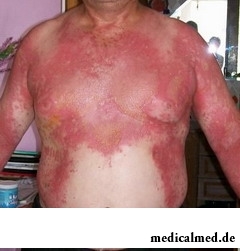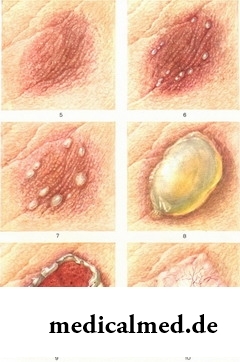





Radiation injuries
Radiation injury is the damage of fabric caused by influence of the ionizing radiation. The term "ionizing radiation" is meant as the waves of high energy which are let out by artificial or natural sources having ability to get and ionize environment objects. The damage of fabrics caused by radiation can be carried out by short-term (single) or long influence.
The term "ionizing radiation" is meant as the waves of high energy which are let out by artificial or natural sources having ability to get and ionize environment objects. The damage of fabrics caused by radiation can be carried out by short-term (single) or long influence.
Radiation injuries can be a consequence of radiation therapy at which are affected not only struck, but also some part of healthy fabrics. Under the influence of radiation in an organism pathological process develops. If the dose was tolerant, it regresses independently, leaving only softly expressed marks of a sclerosis and an atrophy of fabrics (local reaction to radiation). In case of exceeding of admissible doses of influence there are radiation injuries of irreversible character. The obliteration of vessels, a sclerosis, a degeneration of nerve fibrils and the terminations, an atrophy of fabrics with substitution with the hyalinized connecting fabric are the cornerstone of damages.
Classification of radiation injuries
Radoactive radiation can cause two types of radiation injuries: acute and chronic.
Acute (immediate) radiation injuries have two clinical forms:
- Acute radial illness. It is characterized by external beta, gamma neutron radiation;
- Acute focal radiation injuries. Are caused by a contact way (hit of radiative effects on clothes, skin, mucous membranes).
Chronic radiation injuries are shown in the form of a chronic radial illness and arise owing to long external or internal radiation. Degree of manifestation of chronic radiation injuries is caused by a total exposure dose, and also physiological features of this or that body.
Typical manifestations of a chronic radial illness are the regional disturbances of blood circulation in extremities, skin, a brain which are shown in the form of headaches, weakness, a chill in extremities, neurologic symptoms, changes of cordial activity, a digestive tract, an asthenic syndrome.
One of the most common forms of focal radiation injuries - beam dermatitis. The uneven radiative effects are the reason of its emergence at accidents on atomic installations, explosions of ammunition, and in living conditions - roentgenotherapies of tumoral and not tumoral diseases. Frequent localization of focal radiation injuries are fingers, hands, a face, the front surface of hips.
Radiation injuries of skin
Classification  of radiation injuries of skin is also subject to division on acute and chronic.
of radiation injuries of skin is also subject to division on acute and chronic.
Acute radiation injuries of skin represent such diseases as:
- Early beam reaction (represents the edematous erythema which is followed by a small itch and not less than 3 Gr develop for 1-2 days after radiation in a dose);
- Beam alopecia. Not less than 3,75 Gr are followed by loss of long hair two-four weeks later after radiation by a dose;
- Acute beam dermatitis. Appears within 2 months from the moment of radiation. The erythematic form of defeat is noted at a dose of 8-12 of Gr, differing from other dermatitis in crimson and cyanotic skin color, feeling of pain, itch, a hair loss;
- Acute violent dermatitis. Not less than 12-20 Gr are characterized by a radiation dosage, being followed by fervescence, pronounced pains and burning. Healing of erosion after opening of bubbles happens slowly and is followed by pigmentation disturbance, development of an atrophy, teleangiectasias;
- Acute necrotic dermatitis develops after radiation by a dosage over 25 Gr and is followed by painful pains, a fever, high temperature, weakness. Damages of skin are presented in the form of hypostases, erity, bubbles after which opening appear is long not healing ulcers. When healing wounds hems which insignificant traumatizing can lead to a necrosis of fabrics are formed.
Chronic radiation injuries of skin, in turn, are subdivided on:
- The chronic beam dermatitis developing on site acute dermatitis. The disease is clinically shown by a skin atrophy, dryness, formation of painful cracks against the background of which emergence of a papillomatosis and hyperkeratosis is possible.
- Late beam dermatosis (in the form of indurative hypostasis, a late beam ulcer, beam cancer).
Indurative hypostasis develops as a result of damage of small absorbent vessels and, as a result, disturbance of outflow of a lymph. Clinical implication - dense hypostasis without any painful feelings on which permission there are a teleangiectasia and an atrophy of fabrics.
Against the background of trophic changes of skin the late beam ulcer which is characterized by the expressed painful feelings is formed. In the course of long existence of beam ulcers such disease hard to cure as beam cancer can develop.
Prevention of radiation injuries
It is possible to carry the pharmacological drugs reducing weight of manifestation of radiation injury of an organism to the means performing prevention of radiation injuries. They include the medicines increasing radiation resistance of an organism, radioprotectors, antiactinic drugs, medicines capable to stop (to prevent) manifestations of priming reaction on radiation exposure.
According to researches, the women drinking several glasses of beer or wine in a week have the increased risk to develop breast cancer.

Physical activity is necessary for normal functioning of a human body. At a lack of the movement cease функц...
Section: Articles about health
Weakness of an ankle joint – very widespread problem. Its existence is demonstrated by tendency to a podvorachivaniye of legs when walking on heels, frequent painful sprains, pain on average and anonymous toes even after small nagruzo...
Section: Articles about health
For the person who daily since morning gathers for work it is very important to wake up vigorous and ready by day of work. Actually, each of us experiences difficulties with this, at first sight, simple business from time to time. After night rest exert impact on a condition of an organism the weather which collected for several days fatigue, household and office problems, quality of a dream and many other factors....
Section: Articles about health
New year, wedding, birthday, office party – an occasion to drink at the Russian person will always be. How to reduce a negative impact...
Section: Articles about health
The unpleasant feelings connected with spring breakdown are familiar almost to each of us. Often happens that in March-April on the person weakness leans: he suffers from drowsiness, complains of bad mood, loss of interest in life and failures in affairs....
Section: Articles about health
Frosty air, fresh wind and easy snowball at most of Russians are associated with cheerfulness, health and cheerful entertainments on which our winter is so generous. But, unfortunately, cold season sometimes brings also troubles with health. It is not about seasonal colds and frostbites, and about those chronic illnesses which symptoms are shown preferential in the winter....
Section: Articles about health
Life of the modern child is extremely active and difficult. Information strain which is experienced by the school student and did not dream the pupil...
Section: Articles about health
Good appetite was always considered as a sign of good health. The correct operation of the mechanism which is responsible for the need for nutrients and receiving pleasure from process of its satisfaction demonstrates that the organism functions without special from...
Section: Articles about health
The concept "gluten" (differently, a gluten) combines group of the proteins which are a part of rye, barley and wheat. For most of people the use of the food stuffs containing a gluten not only is safe, but also it is very useful. Nevertheless, there is a number of myths about negative effect which allegedly gluten has on health of the person....
Section: Articles about health
The advantage of swimming for the person is so high that this sport is not only the most popular, but also is widely applied in copper...
Section: Slideshow
Extracorporal fertilization – one of the most modern methods of controlling with infertility. So far he already helped a significant amount of married couples to become happy parents. Usually to the EKO procedure difficult and very expensive, resort in those...
Section: Articles about health
Water with a lemon - idle time in preparation drink which supporters of a healthy lifestyle already managed to appreciate. Used in a warm look and on an empty stomach, it is one of the most useful prophylactics allowing to prevent tens of diseases and just to raise an organism tone. Especially effectively to use warm water with lemon juice after a serious illness, during a season of the colds, and also to children, old men and pregnant women which do not have contraindications...
Section: Articles about health
On the head of the person about one million hair follicles, or as they are called still, hair bulbs are located. At the moment he is born...
Section: Articles about health
The depression not without reason is considered one their main troubles of our century: for scientific and technical progress, acceleration of rate of life and a surplus of information of people it is forced to pay with stresses, negative emotions and weakening of protective forces of an organism. As a result ш...
Section: Articles about health
Cold, puffiness of a nose, itch, the watering eyes - characteristic symptoms of the allergic rhinitis resulting from hit of allergens (pollen, house dust, hair of animals, etc.) on a mucous membrane of a nose. Unpleasant feelings often give trouble, serving as the reason of a headache, an acrimony, sleep disorders, and in certain cases and the states close to a depression. How to get rid of undesirable satellites of a disease if near at hand there are no antiallergic...
Section: Articles about health
Each person has easy indispositions which he transfers "standing", trying not to ask for medical care. Argu...
Section: Articles about health
Life expectancy in various regions of Earth is not identical. Social stability, economic wellbeing, availability and level of medical care, household comfort, literacy of the population in the field of observance sanitary гигиен exert impact on it...
Section: Articles about health
What will only not be thought up by persons interested to have a beautiful figure. Here the last innovation – for weight loss needs to be eaten greasy food. Let's understand whether there is at a fatty diet common sense....
Section: Slideshow
Use of medicinal plants in therapy is urgent today, more than ever. The drugs made of curative herbs cannot on...
Section: Articles about health
Any person who faced a disease knows that treatment costs expensive. It belongs also to consultations of qualified specialists, and to the diagnostic procedures which are not included in the list of obligatory medical services. Question of cost of medicinal Wednesday...
Section: Articles about health
Obesity is called a disease of 21 centuries, for the last 100 years the number of the people suffering from excess body weight considerably increased. Statistically, on Earth already about 1,5 billion corpulent people, and 500 million from them have the extreme degree of completeness negatively affecting quality and duration of their life. What served as the reason of growth of stout persons on the planet? How not to get to their ranks? Let's consider five main premises for increase in body weight in conditions современнос...
Section: Articles about health
One of the major chemical processes happening in a human body are oxidation reactions. They go with participation of fats...
Section: Articles about health
The immunity role in growth of the child is invaluable. The proteins-immunoglobulins produced by immune system preserve the child against the diseases capable − owing to an organism weak still − to serve as a stressful factor, to become the reason of many complications and delays in unless...
Section: Articles about health
White teeth and the Hollywood smile – a dream of many people. Long time was considered that the plaque on teeth and change of their color – destiny of those who incorrectly eat smokes and badly brushes teeth. But the paradox is available: at everything the variety of toothpastes, brushes existing today for toothbrushing and conditioners for a mouth the number of the people hesitating of a plaque on teeth does not decrease. Moreover, the plaque is formed even at small children who definitely do not smoke and have no coffee. So in what business, and опас...
Section: Articles about health
It is possible to find the extensive range of fruit and vegetables in modern shops. Russians already got used that on counters in any...
Section: Articles about health
To look healthy and means well-groomed not only to be pleasant to people around, but also to feel strong, sure and taken place. Specialists in the field of cosmetology quite often note that whether not all women are able to look after skin...
Section: Articles about health
Practice of hypnotic impact on consciousness of the person contains about two millennia. During this time scientists managed to learn a lot of things about a phenomenon of hypnosis and learned to facilitate a condition of the patients having heavy illnesses with its help....
Section: Articles about health
